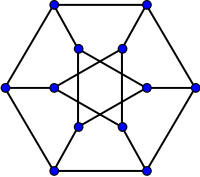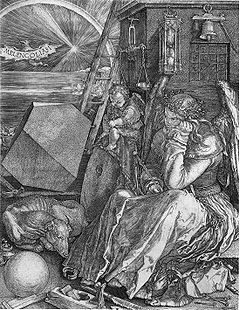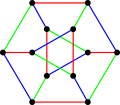| v · cubic graph of girth 3 and diameter 4. As well as its construction as the skeleton of Dürer's solid, it can be obtained by applying a Y-Δ transform to the opposite vertices of a cube graph, or as the generalized Petersen graph G(6,2). As with any graph of a convex polyhedron, the Dürer graph is a 3-vertex-connected simple planar graph.
The Dürer graph is a well-covered graph, meaning that all of its maximal independent sets have the same number of vertices, four. It is one of four well-covered cubic polyhedral graphs and one of seven well-covered 3-connected cubic graphs. The only other three well-covered simple convex polyhedra are the tetrahedron, triangular prism, and pentagonal prism.[4]
The Dürer graph is Hamiltonian, with LCF notation [-4,5,2,-4,-2,5;-].[5] More precisely, it has exactly six Hamiltonian cycles, each pair of which may be mapped into each other by a symmetry of the graph.[6]
Symmetries
The automorphism group both of the Dürer graph and of the Dürer solid (in either the truncated cube form or the form shown by Dürer) is isomorphic to the dihedral group of order 12 : D6.
Gallery
-
The chromatic index of the Dürer graph is 3.
-
The chromatic number of the Dürer graph is 3.
-
The Dürer graph is Hamiltonian.
Notes
- ^ Weisstein, Eric W., "Dürer's Solid" from MathWorld.
- ^ Weber (1900). According to Lynch (1982), the contrary hypothesis that the shape is a misdrawn truncated cube was promoted by Strauss (1972).
- ^ See Weitzel (2004), from which most of the following history is drawn.
- ^ Campbell & Plummer (1988); Campbell, Ellingham & Royce (1993).
- ^ Castagna and Prins attribute the proof of Hamiltonicity of a class of generalized Petersen graphs that includes the Dürer graph to a 1968 Ph.D. thesis of G. N. Robertson at the University of Waterloo. See Castagna, Frank; Prins, Geert (1972), "Every Generalized Petersen Graph has a Tait Coloring", Pacific Journal of Mathematics 40 .
- ^ Schwenk, Allen J. (1989), "Enumeration of Hamiltonian cycles in certain generalized Petersen graphs", Journal of Combinatorial Theory, Series B 47 (1): 53–59, doi:10.1016/0095-8956(89)90064-6, MR1007713 .
References
- Campbell, S. R.; Ellingham, M. N.; Royle, Gordon F. (1993), "A characterisation of well-covered cubic graphs", Journal of Combinatorial Mathematics and Combinatorial Computing 13: 193–212, MR1220613 .
- Campbell, Stephen R.; Plummer, Michael D. (1988), "On well-covered 3-polytopes", Ars Combinatoria 25 (A): 215–242, MR942505 .
- Lynch, Terence (1982), "The geometric body in Dürer's engraving Melencolia I", Journal of the Warburg and Courtauld Institutes (The Warburg Institute) 45: 226–232, doi:10.2307/750979, JSTOR 750979 .
- MacGillavry, C. (1981), "The polyhedron in A. Dürers Melencolia I", Nederl. Akad. Wetensch. Proc. Ser. B 84: 287–294 . As cited by Weitzel (2004).
- Richter, D. H. (1957), "Perspektive und Proportionen in Albrecht Dürers “Melancholie”", Z. Vermessungswesen 82: 284–288 and 350–357 . As cited by Weitzel (2004).
- Schreiber, Peter (1999), "A new hypothesis on Dürer's enigmatic polyhedron in his copper engraving “Melencolia I”", Historia Mathematica 26: 369–377, doi:10.1006/hmat.1999.2245 .
- Schröder, E. (1980), Dürer, Kunst und Geometrie, Dürers künstlerisches Schaffen aus der Sicht seiner “Underweysung”, Basel . As cited by Weitzel (2004).
- Strauss, Walter L. (1972), The Complete Engravings of Dürer, New York, p. 168, ISBN 0486228517 . As cited by Lynch (1982).
- Weber, P. (1900), Beiträge zu Dürers Weltanschauung—Eine Studie über die drei Stiche Ritter, Tod und Teufel, Melancholie und Hieronymus im Gehäus, Strassburg . As cited by Weitzel (2004).
- Weitzel, Hans (2004), "A further hypothesis on the polyhedron of A. Dürer's engraving Melencolia I", Historia Mathematica 31 (1): 11–14, doi:10.1016/S0315-0860(03)00029-6 .
Categories: - Individual graphs
- Polyhedra
- Regular graphs
- Planar graphs
Wikimedia Foundation.
2010.
Look at other dictionaries:
Dürer — Dürer, 1) Albrecht, Maler, Grafiker, Zeichner und Kunstschriftsteller, * Nürnberg 21. 5. 1471, ✝ ebenda 6. 4. 1528, Bruder von 2). Die Familienchronik, das Tagebuch der niederländischen Reise, Briefe und viele eigenhändige Niederschriften geben … Universal-Lexikon Albrecht Dürer — The title of this article contains the character ü. Where it is unavailable or not desired, the name may be represented as Albrecht Duerer. Albrecht Dürer Self Portrait (1500) by Albrecht Dürer … Wikipedia Petersen graph — Infobox graph name = Petersen graph image caption = The Petersen graph is most commonly drawn as a pentagon with a pentagram inside, with five spokes. namesake = Julius Petersen vertices = 10 edges = 15 radius = 2 diameter = 2 girth = 5 chromatic … Wikipedia Projet:Mathématiques/Liste des articles de mathématiques — Cette page n est plus mise à jour depuis l arrêt de DumZiBoT. Pour demander sa remise en service, faire une requête sur WP:RBOT Cette page recense les articles relatifs aux mathématiques, qui sont liés aux portails de mathématiques, géométrie ou… … Wikipédia en Français List of mathematics articles (C) — NOTOC C C closed subgroup C minimal theory C normal subgroup C number C semiring C space C symmetry C* algebra C0 semigroup CA group Cabal (set theory) Cabibbo Kobayashi Maskawa matrix Cabinet projection Cable knot Cabri Geometry Cabtaxi number… … Wikipedia soutenir — [ sut(ə)nir ] v. tr. <conjug. : 22> • déb. XIIIe; sostenir Xe; lat. pop. °sustenire, class. sustinere, de sub « sous » et tenere « tenir » I ♦ 1 ♦ Tenir (qqch.) par dessous, en position de stabilité, en … Encyclopédie Universelle Grafische Sammlung München — Die Staatliche Graphische Sammlung in München gehört zu den wichtigsten Grafik Sammlungen der Welt und ist neben den Kupferstichkabinetten von Berlin und Dresden die bedeutendste Einrichtung dieser Art in Deutschland. Sie beherbergt einen Bestand … Deutsch Wikipedia Graphische Sammlung München — Die Staatliche Graphische Sammlung in München gehört zu den wichtigsten Grafik Sammlungen der Welt und ist neben den Kupferstichkabinetten von Berlin und Dresden die bedeutendste Einrichtung dieser Art in Deutschland. Sie beherbergt einen Bestand … Deutsch Wikipedia Muschelkurve — Die Konchoide (v. griech. Muschel) ist eine spezielle ebene Kurve. Sie beschreibt die Bewegung eines Punktes, der – von einem festen Punkt (Pol) aus gesehen – zu einer gegebenen Kurve konstanten Abstand einhält. Inhaltsverzeichnis 1 Eigentliche… … Deutsch Wikipedia Staatliche Grafische Sammlung München — Die Staatliche Graphische Sammlung in München gehört zu den wichtigsten Grafik Sammlungen der Welt und ist neben den Kupferstichkabinetten von Berlin und Dresden die bedeutendste Einrichtung dieser Art in Deutschland. Sie beherbergt einen Bestand … Deutsch Wikipedia
|





